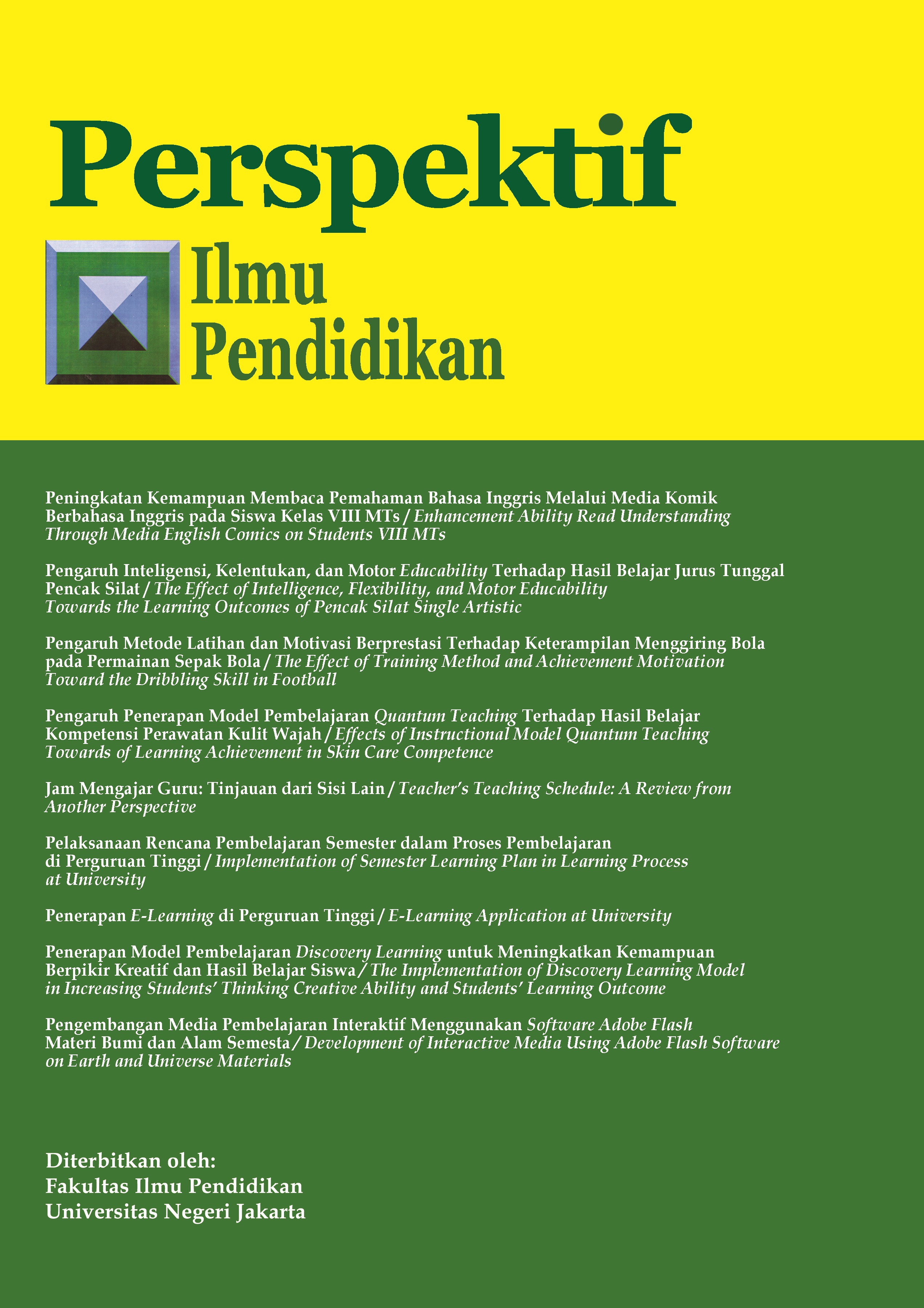PENGEMBANGAN MEDIA PEMBELAJARAN INTERAKTIF MENGGUNAKAN SOFTWARE ADOBE FLASH MATERI BUMI DAN ALAM SEMESTA
DOI:
https://doi.org/10.21009/PIP.321.9Keywords:
interactive learning media, Adobe Flash software, earth and universe materialsAbstract
The study aims to develop interactive learning media using Adobe Flash Professional CS6 software on Earth and Universe materials for third-grader students in primary school. The types of the study are research and development which carried out by using Borg and Gall's model development and modified into 7 development steps, which are (1) research and information collecting; (2) planning; (3) develop preliminary form of product; (4) preliminary field testing; (5) main product revision; (6) main field testing; and (7) operasional product revision. The study was conducted on April 2018 in two primary schools in Salatiga. The subjects of the study involved 10 third-grader students of primary school on preliminary field testing and 32 third-grader students of primary school on the main field testing. The results of validity test from the media expert obtained an average scores of 3,9 with a good category. The results of validity test from the material expert obtained average scores of 2.95 with good enough category. The result of students questionnaire on preliminary field testing showed the average scores of 4.5 and the result of the students questionnaire on main field testing showed the average scores of 4,6 with a very good category. Then, the result of teachers questionnaire showed an average of 5.0 on preliminary field testing and 4.8 on main field testing with a very excellent category. Based on the validation of material experts, media experts, the results of questionnaire responses of both students and teachers, interactive learning media that developed by adobe flash software of earth and the universe materials are suitable in learning for third grader of Primary School students and can enhance students’ interest in learning materials and build students’ learning motivation.
References
Apriyani, T. (2015). Pengembangan media pembelajaran interaktif Adobe Flash CS5 untuk meningkatkan keterampilan membaca teks pendek bahasa prancis siswa kelas XI SMA El Shadai Magelang. Disertasi. Universitas Negeri Yogyakarta.
Arikunto, S. (2013). Prosedur penelitian suatu pendekatan praktik. Jakarta: Rineka Cipta.
Darmawan, D. (2012). Inovasi pendidikan: pendekatan praktik teknologi multimedia dan pembelajaran
online. Bandung: Remaja Rosdakarya.
Hasan, A. M. (2003). Pengembangan profesionalisme guru di abad pengetahuan. Malang: PPS Universitas Negeri Malang. Diakses melalui http://www.tcpdf.org pada tanggal 18 Oktober 2011
Indriana, D. (2011). Ragam alat bantu media pengajaran. Yogjakarta: Diva Press.
MADCOMS. (2013). Adobe Flash CS6. Yogyakarta: Andi Offset.
Mawardi. (2018). Merancang model dan media pembelajaran. Scholaria: Jurnal Pendidikan dan Kebudayaan,
8(1), 26-40. doi: https://doi.org/10.24246/j.js.2018.v8.i1.p26-40
Prayogo, P. D. (2015). Pengembangan multimedia interaktif tematik untuk siswa kelas IV SD Muhammadiyah Condongcatur. E-Jurnal Skripsi Mahasiswa TP, IV(7). http://journal.student.uny.ac.id/ojs/index.php/fiptp/article/view/756
Puspitasari, R. N. (2010). Upaya peningkatan prestasi belajar IPA siswa kelas III melalui penerapan metode guided inquiry-discovery. Disertasi. Surakarta: UNS.
Radia, E. H. (2016). Upaya meningkatkan hasil belajar pada siswa kelas III melalui model belajar kontekstual berbantuan media benda konkret pada mapel Ilmu Pengetahuan Alam di SD Negeri Sidorejo Kidul 03 semester I tahun ajaran 2016/2017. Disertasi. Salatiga: Program Studi Pendidikan Guru Sekolah Dasar FKIP-UKSW.
Rahmaibu, F. H., Ahmadi, F., & Prasetyaningsih, F. D. (2017). Pengembangan media pembelajaran menggunakan adobe flash untuk meningkatkan hasil belajar PKn. Jurnal Kreatif: Jurnal Kependidikan Dasar, 7(1), 1-10. https://journal.unnes.ac.id/nju/index.php/kreatif/article/view/9362
Sa'ud, U. S. (2012). Inovasi pendidikan. Bandung: Alfabeta.
Sanoto, H., & Pulungan, D.S. (2014). Pengembangan pembelajaran IPA SD. Salatiga: Widya Sari Press.
Slameto. (2011). Pengembangan model pembelajaran kreatif untuk meningkatkan prestasi belajar siswa Kelas IV SD RSBI Kota Salatiga. Satya Widya: Jurnal Penelitian Pengembangan Kependidikan, 27(1), 111-135. http://repository.uksw.edu/handle/123456789/6164
Slameto. (2015). Generation Z and the implications for counseling. Proceeding Seminar and Workshop Mid Year APECA 2015 in Salatiga. Diakses melalui http://repository.uksw.edu/handle/123456789/6862.
Slameto., N. S. Wardani, & F Kristin. (2016). Pengembangan model pembelajaran berbasis riset untuk meningkatkan keterampilan berpikir aras tinggi. Prosiding Konser Karya Ilmiah Nasional 2016. “Komunikasi Hasil Riset, Pengabdian Masyarakat, dan Produk-Produk Unggulan yang Berdaya Saingâ€. Diakses melalui http://repository.uksw.edu/handle/123456789/8688.
Sukarno. (1981). Dasar-dasar pendidikan sains. Jakarta: Bhatara Karya Aksara.
Suyono & Hariyanto. (2014). Belajar dan pembelajaran. Bandung: Remaja Rosdakarya.
Undang-Undang Republik Indonesia No 20 Tahun 2003 tentang sistem pendidikan.
Yunita, R. (2017). Pengembangan multimedia adobe flash CS5 berbasis STAD sebagai media pembelajaran
IPA pada pokok bahasan sistem gerak pada manusia untuk SMP/MTs. Disertasi. Lampung: IAIN Raden Intan Lampung.
Downloads
Published
How to Cite
Issue
Section
License
Authors who publish with this Journal agree to the following terms:
- Author retain copyright and grant the journal right of first publication with the work simultaneously licensed under a creative commons attribution licensethat allow others to share the work within an acknowledgement of the work’s authorship and initial publication of this journal.
- Authors are able to enter into separate, additional contractual arrangementfor the non-exclusive distribution of the journal’s published version of the work (e.g. acknowledgement of its initial publication in this journal).
- Authors are permitted and encouraged to post their work online(e.g. in institutional repositories or on their websites) prior to and during the submission process, as it can lead to productive exchanges, as well as earlier and greater citation of published works.
-
Users/public use of this website will be licensed to CC BY-NC-SA Creative Commons Attribution-NonCommercial-ShareAlike 4.0 International License












